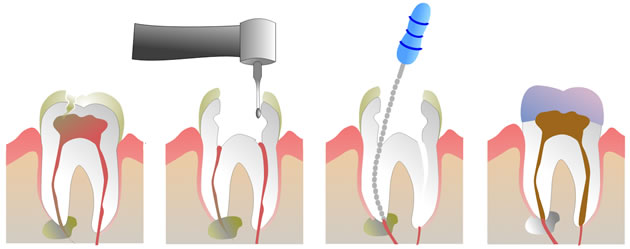Root Canal Treatments
When a tooth becomes very painful due to damage to the pulp, or develops an abscess, then root canal therapy may be the only way to save the tooth.
This treatment is done by removing the nerve and filling the root canal, and then restoring the tooth.
Crowns are often needed for root filled teeth, as they can become more brittle.
What is root canal treatment?
Root canal treatment involves removing the soft inner tissue of a tooth. This is sometimes necessary in teeth that are causing the patient discomfort as well as teeth that are totally asymptomatic.
There are multiple reasons that your dentist may recommend root canal treatment. The ultimate goal is to save a tooth that is otherwise unable to be saved.
An endodontic procedure can save your tooth.
Why root canal treatment?
A healthy, restored tooth is always better than an artificial one. With better technology and anaesthetics, root canal procedures are painless and can now be completed in one or two visits.
Are there any complications in the procedure?
While it is possible to have complications, root canal therapy is successful approximately 95% of the time and the restored tooth can last a lifetime with proper dental care.
The steps of a root canal procedure are:
- Local anaesthetic is administered.
- Tooth is isolated from saliva.
- A small opening is made in the top of the tooth
- Pulp is removed from pulp chamber and root canal(s)
- Root canal(s) is cleaned, enlarged, and shaped so that it can be properly filled
- Canals are then sealed and the tooth is ready for final restoration
- A crown is usually placed over the tooth to prevent it from fracturing
Benefits of root canal treatment:
- Save the tooth
- Add immense relief
- End infection/discomfort
- Regenerate bone tissue
All back teeth with root canals should be protected with a crown.
Once the pulp of the tooth has died or has been removed, the tooth no longer has its hydrating mechanism and becomes somewhat brittle and more prone to fracture. It is important that all back teeth (molars and premolars) that have been endodontically treated be protected with crowns to prevent fracture and to restore their appearance. (This is somewhat less necessary with front teeth because they have a smaller biting table and, as a result, are less prone to fracture in function. However, discoloured root canal treated teeth need to be crowned.)
Root Canal fillings
- A Deep Infection - Root canal treatment is needed when the tooth's root becomes infected or inflamed through injury or advanced decay.
- A Route to the Root - The tooth is anesthetized. An opening is made through the crown of the tooth to the pulp chamber.
- Removing the Infected/Inflamed Tissue - Special files are used to clean the infection and unhealthy pulp out of the canals. Irrigation is used to help clean the root canal.
- Filling the Canals -The canals are filled with a permanent material, often gutta-percha. This helps to keep the canals free of infection or contamination.
- Rebuilding the Tooth - A temporary filling material is placed on top of the gutta-percha to seal the opening until the tooth is ready to be prepared for a crown. A crown, sometimes called a cap, is made to look like a natural tooth, and is placed on top.
- Extra Support - In some cases, a post is placed to give the crown extra support.
- The Crowning Touch - The crown is cemented into place.

Copyright © 2022 Healthy Smile Alanya Turkey. Evren Yazılım



 +90 531 342 70 82
+90 531 342 70 82







